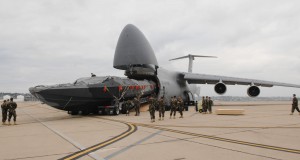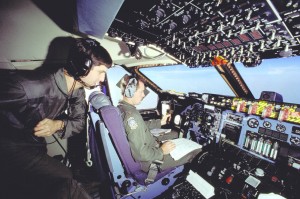
Published on June 30, 2012
On this date in aviation history, the Lockheed C-5 Galaxy cargo plane made its first flight. One of the largest cargo aircraft in history, the aircraft has formed the backbone of the USAF’s heavy strategic cargo lifting capability for nearly 50 years, despite numbering just under 100 aircraft in total in the current inventory.
Discounting one-off prototypes, the C-5 has only been surpassed by the Russian Antonov An-124 (first flight in 1982) and the Boeing 747-8x. Even if the 747s can carry a heavier load, they cannot carry extra wide cargo. Further, the 747 is typically side-door loaded, so extra long cargo loads that would require a straight-in / straight-out load cannot be fitted within the fuselage. Only the C-5 is widely deployed, combat-ready aircraft, putting it in the special category of true strategic military airlift aircraft.
Key Features of the C-5
The C-5 is a completely pressurized aircraft, including the cargo area, something which comparable Russian aircraft do not feature. The C-5 has a roller floor for quick cargo positioning and tie-down and it features onload/offload ramps at both the nose and the tail. The aircraft can carry a full load of cargo, plus seat an additional 75 passengers and crew on an upper rear deck, above the cargo floor. In addition, a complete cargo load of as many as 33 type 463L pallets can be loaded quickly with standard USAF K-loaders (without reducing the passenger counts). Typically, each pallet will weigh between 3,000 and 5,000 pounds, though heavier pallets, like ammunition, may be 10,000 pounds or more. When flying across the Atlantic Ocean to Europe, a typical C-5A or C-5B mission will haul at least 150,000 pounds of cargo on a single flight.

Over the years, the C-5 has served in a wide variety of roles — everything from “hauling trash” (general cargo) to Europe from the USA, to delivering urgent humanitarian relief supplies in the immediate aftermath of a natural disaster. As a military aircraft, it offers a number of mission critical capabilities that are second to none. Among the highlights, it can operate into and out of unprepared strips at all times, day and night, in almost all weather, offloading cargo with night vision gear and no visible lighting. Every vehicle in the US Army’s inventory can be carried on board and, for shorter distances, usually more than one of each can be carried. For instance, the C-5 can fly up to six Boeing AH-64 Apache helicopters or five Bradley Fighting Vehicles in a single load.
Introducing the C-5M Super Galaxy
Of the 77 C-5As and 50 C-5Bs that were built, 2 of the A models and 49 of the B models, plus the two C models (designed for certain outsized cargo) are undergoing a modernization upgrade at this time to produce the C-5M Super Galaxy. With upgraded engines, advanced avionics, new electrical systems, a new communications suite and navigation panel, plus a host of other upgrades and improvements, the C-5M will set the standard for heavy lift for years to come.
At nearly 50 years and still going strong, the C-5 Galaxy will likely be in service with the USAF for another few decades. In fact, a USAF study concluded in 2004 that the C-5 fleet still had 80 percent of their airframe life expectancy ahead of them. It is likely that some of the aircraft will exceed 75 years flying missions around the globe before retirement. Some may make it to 100 years in the air, a fact that none of its original designers could have imagined when the great planes rolled off the assembly lines all those years ago.
At Lockheed, they built them to last.
One More Bit of Aviation Trivia
In 1947, the Hughes H-4 Hercules (aka “Spruce Goose”) was the largest aircraft ever designed. It had a wingspan of 320 feet and 11 inches. When it was completed after five years of development work, the war it was designed to support had already ended more than two years earlier. It was designed to carry a load of 750 troops to Europe. Hughes staked his reputation on the aircraft and, had it not successfully flown, he had even threatened to leave the country and never come back. As it turned out, despite the naysayers, Hughes flew it himself in 1947 — just once and only lifting off the water for a total distance of 70 feet. Hughes then declared it a success and summarily retired the aircraft. Today, the Spruce Goose is on display at the Evergreen Aviation Museum in McMinnville, Oregon. Notably, the lifting capacity (in tonnage) of a C-5 Galaxy easily exceeds the maximum possible load of the Spruce Goose.

Hello,
My Name is Troy Mauldin, and I love the planes of the US Air Force. I am currently in the AFJROTC program at Palmetto High School in South Carolina and I plan to join the service. Almost every day I look through books, websites, and catalogs to review the US Air Force and I must say this one of the reasons why I love the United States.
What was the date of the first flight?
How do the passengers riding in the rear upper deck seats get to the upper deck? Is there a ladder?
I visited in DOVER, DE, at the Air Mobility Museum and went through a C-5. The guide said there were 77 seats in the upper rear deck that face backwards but everything I’ve read say 75 seats.
Thank you for this. My dad was a flight engineer on the C-5A “Fat Albert” on the Good Will Ambassador Tour when it first came out. So proud of him and all our miltitary!!